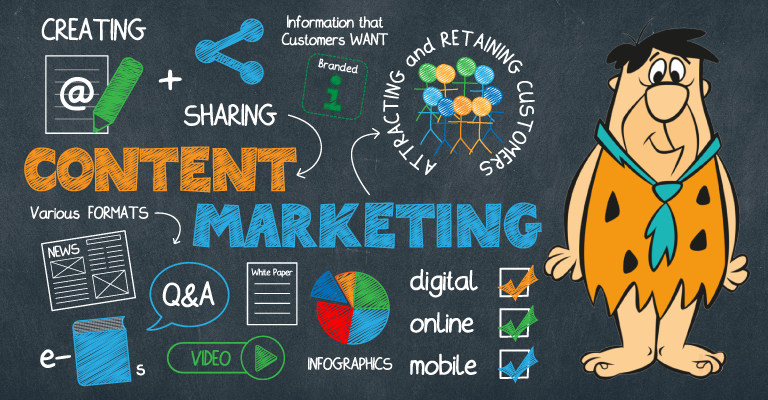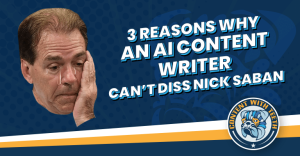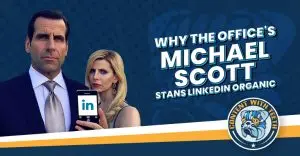Table of Contents
- What Is Content Marketing?
- Hypothetical Content Marketing Efforts
- The Benefits of Content Marketing
- What Do Content Marketers Do?
- Content Formats and How It All Works
- Yabba Dabba Content!
Is content marketing so easy a caveman could do it?
Content marketing assumption vs how it really works. pic.twitter.com/9xaxmHqPdG
— Mehmed Aezhad (@MehmedAezhad) May 13, 2020
Does Fred Flintstone, the most genial of cavemen, throw up a blog or video on bedrock.io, have prospects click, and the dough starts rolling in?
We’ll explain in this post how it’s a little more complicated than that.
Why You Should Care?
What is Content Marketing?
2 x 280 characters should do it:
You've been hearing a lot about Content Marketing, you are going to hear it again now. It's unavoidable if what you want is massive growth for your brand/business.
If you've outgrown growth already, you don't need this. Hop off.
Simply put, Content Marketing is the act of
— Jay Jay ✍️ (@Johnsonn_Love) September 30, 2022
of creating content that'll educate, attract, and engage your prospects to ultimately make sales.
Breaking that down;
When you educate & engage your prospects about your products or brand, what you are doing is called content marketing.
An example for your perusal…
— Jay Jay ✍️ (@Johnsonn_Love) September 30, 2022
Content marketing fuels your efforts by keeping your brand in front of your audience and connecting with potential customers. It also gives you the chance to increase traffic to your website, establish trust, develop brand personality and support the conversion funnel where prospects become aware of your brand and progress downward to the point where they become actual customers.
A content marketing strategy is a non-intrusive way to reach your target audience and help them with their pain points and challenges through valuable information like industry news, case studies, guides, and more. Content marketing differs from traditional advertising because it focuses on customers rather than a business’s products and services.
Hypothetical Content Marketing Efforts

Let’s say you have a travel agency and want to create brand awareness while helping your customers achieve a trip they’ll never forget.
You understand that your buyer is having a rough time putting together a travel plan that will not make them choose between eating or traveling. So, you establish a documented content marketing strategy that will answer their questions, plus let them know you’re the ultimate guide to building the perfect travel plan.
You decide to use Instagram to create educational social media posts about the benefits of a complete travel plan, industry news, testimonials, case studies, and other content assets. Next, you offer them a free guide to help them see hotels, airfare, and the best dates to travel.
Once they have downloaded the guide and given you their contact information, it’s time to nurture them with an email campaign. You’ll soon determine which leads are interested in buying your services or are still considering purchasing in the future.
This example is a glance at how content works, but there are still a few details ahead. Check out our past blog post on creating content that converts!
The Benefits of Content Marketing

Before we see how the gears grind, let’s explore some of the benefits of content over traditional marketing:
Customer engagement: by crafting your content for your blog, social media platforms, landing page or website, you’re more than likely to reach your potential audience and the conduit — search engines like Google.
Brand awareness and thought leadership: by talking about your industry and educating your audience about what you do, you’re allowing them to find answers and learn more about or process. They’ll see you as a reliable source of information and a credible company.
Lead generation and nurturing: if you have a free eBook and offer it in exchange for your audience’s contact information, you’ll quickly gain potential leads to nurture them down your sales funnel. Likewise, an email campaign will let you connect with your prospects and provide insight to see which contacts are ready to become a customer based who opens and engages with your email content.
Sales enablement: content marketing isn’t just for the marketing department; your sales team can share the content your team creates to help your audience find the answers they need. If you create a video FAQ on your website, the sales team can copy the link and send it to prospects instead of wasting time regurgitating stock answers.
What Do Content Marketers Do?

Content marketers are responsible for creating content that resonates with their ideal buyer persona, follows their brand’s tone of voice, and uses easy-to-follow language.
These are some of the skills they need to have:
- The ability to do deep research on a specific subject
- They need to understand a brands voice like it’s their own
- Understand basic search engine optimization (SEO) concepts like keyword optimization
- Strategy and analysis capabilities to identify which assets work and which don’t
- The ability to produce content in various formats and with key players like influencers, actors, designers, writers, videographers, etc.
Content Formats and How It All Works
Our top eight content formats will succeed in your marketing efforts!
- Blog Posts
- EBooks and Whitepapers
- Infographics and Visual Design
- Videos
- Case Studios
- Website Copy
- Newsletters and Emails
- Social Media
Blog Posts
These deserve your attention because they help your website become discoverable by powerful magnets like Google. In summary, you have two significant advantages: you’ll educate your audience about your industry and help the search engine rank your content better on a results page (SERP).
With a blog, you have an opportunity to bring people to your site and increase the chances of conversions. For example, let’s say you saw this post on one of our social media channels, clicked on it, landed on our site, read it, saw our eBook, downloaded it, and PRESTO! Now you’re in our monthly newsletter. It’s not too much more complicated than Fred Flintstones’ POST-CLICK-CUSTOMER model.
EBooks and Whitepapers A.K.A. Lead Magnets
If done right, your audience will find enough value in these types of content that they are willing to exchange their contact information for it. It’s not a sale but an indication that your visitors get the answers they need while engaging with your brand. Next, nurture them with an email campaign to get closer to the decision stage.
Newsletter and Emails
Emails are crucial in a content marketing campaign if done right. You have a chance to connect with your target audience even further and lead them down the marketing funnel. To have a successful marketing campaign, you must align your emails or newsletter to your buyer’s context. Let’s say somebody visited your website, downloaded your eBook, and gets an email notification thanking them and inviting them to read more about another topic of interest. It takes twelve touch points or more for people to purchase, so emails are a critical component to splash water in your prospect’s face and keep them engaged.

Infographics and Visual Design
This format suits an audience that might not like to read a whole blog post. On the other hand, maybe your buyers prefer quick information. So, infographics or visual design could be the best way to present your content. Remember that content marketing is consumer-centric, so you must choose the type of format according to what different segments of your audience like to interact with.

Videos
People are consuming at least six hours a day of video content. As a result, it’s increasingly common for brands to use video, especially with TikTok, Instagram Reels, and YouTube Shorts on the rise. So how would you integrate video into your content marketing mix?

Case Studies
This type of format is a valuable tool for closing sales. It gives you more credibility by showing your prospect a feel of the service through another person’s experience. Think of it as a more elaborate written testimonial where you detail the specific steps that benefitted your customer.
Website Copy
Your site is an essential tool, and the copy is crucial. Visitors will probably bounce (visit one page and exit) if you have very long and dense text on your site. Your writing should convey the essential information to help those visitors understand: who you are, what you offer, and how they can connect with you. There are many templates, but a skilled copywriter can help you distill your copy into easy-to-read nuggets that convert.
Social Media
It’s last but certainly not least. These platforms are vital for distributing your content, but which social media is right for your business? It depends on your ideal customer. Understanding your audience, business value proposition, and products and services in full detail will help you choose the right channel to delight your audience with meaningful content.
Yabba Dabba Content!

Here is a formula that would make Fred Flintstone cry out his catch-phrase of contentment:
Put out content so that people will find it and engage with it. Keep pumping out content to keep their interest until they become a customer.
How content marketing works is simple right?
Not really.
This introduction sketches principles, not details. A successful content marketing strategy is a tremendous amount of work. If you want a company that doesn’t go back to the stone ages but can certainly roll a barrel on a round stone, check out Content with Teeth. Tap HERE for a free consultation, or call us at +1 (888) 552-9235.
If you’re just passing through, leave a comment and share this post!








